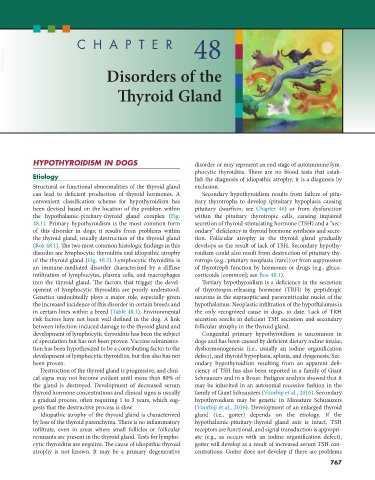Page 795 - Small Animal Internal Medicine, 6th Edition
P. 795
CHAPTER 48
VetBooks.ir
Disorders of the
Thyroid Gland
HYPOTHYROIDISM IN DOGS disorder or may represent an end stage of autoimmune lym-
phocytic thyroiditis. There are no blood tests that estab-
Etiology lish the diagnosis of idiopathic atrophy; it is a diagnosis by
Structural or functional abnormalities of the thyroid gland exclusion.
can lead to deficient production of thyroid hormones. A Secondary hypothyroidism results from failure of pitu-
convenient classification scheme for hypothyroidism has itary thyrotrophs to develop (pituitary hypoplasia causing
been devised based on the location of the problem within pituitary dwarfism; see Chapter 46) or from dysfunction
the hypothalamic-pituitary-thyroid gland complex (Fig. within the pituitary thyrotropic cells, causing impaired
48.1). Primary hypothyroidism is the most common form secretion of thyroid-stimulating hormone (TSH) and a “sec-
of this disorder in dogs; it results from problems within ondary” deficiency in thyroid hormone synthesis and secre-
the thyroid gland, usually destruction of the thyroid gland tion. Follicular atrophy in the thyroid gland gradually
(Box 48.1). The two most common histologic findings in this develops as the result of lack of TSH. Secondary hypothy-
disorder are lymphocytic thyroiditis and idiopathic atrophy roidism could also result from destruction of pituitary thy-
of the thyroid gland (Fig. 48.2). Lymphocytic thyroiditis is rotrops (e.g., pituitary neoplasia [rare]) or from suppression
an immune-mediated disorder characterized by a diffuse of thyrotroph function by hormones or drugs (e.g., gluco-
infiltration of lymphocytes, plasma cells, and macrophages corticoids [common]; see Box 48.1).
into the thyroid gland. The factors that trigger the devel- Tertiary hypothyroidism is a deficiency in the secretion
opment of lymphocytic thyroiditis are poorly understood. of thyrotropin-releasing hormone (TRH) by peptidergic
Genetics undoubtedly plays a major role, especially given neurons in the supraoptic and paraventricular nuclei of the
the increased incidence of this disorder in certain breeds and hypothalamus. Neoplastic infiltration of the hypothalamus is
in certain lines within a breed (Table 48.1). Environmental the only recognized cause in dogs, to date. Lack of TRH
risk factors have not been well defined in the dog. A link secretion results in deficient TSH secretion and secondary
between infection-induced damage to the thyroid gland and follicular atrophy in the thyroid gland.
development of lymphocytic thyroiditis has been the subject Congenital primary hypothyroidism is uncommon in
of speculation but has not been proven. Vaccine administra- dogs and has been caused by deficient dietary iodine intake,
tion has been hypothesized to be a contributing factor to the dyshormonogenesis (i.e., usually an iodine organification
development of lymphocytic thyroiditis, but this also has not defect), and thyroid hypoplasia, aplasia, and dysgenesis. Sec-
been proven. ondary hypothyroidism resulting from an apparent defi-
Destruction of the thyroid gland is progressive, and clini- ciency of TSH has also been reported in a family of Giant
cal signs may not become evident until more than 80% of Schnauzers and in a Boxer. Pedigree analysis showed that it
the gland is destroyed. Development of decreased serum may be inherited in an autosomal recessive fashion in the
thyroid hormone concentrations and clinical signs is usually family of Giant Schnauzers (Voorbijj et al., 2016). Secondary
a gradual process, often requiring 1 to 3 years, which sug- hypothyroidism may be genetic in Miniature Schnauzers
gests that the destructive process is slow. (Voorbijj et al., 2016). Development of an enlarged thyroid
Idiopathic atrophy of the thyroid gland is characterized gland (i.e., goiter) depends on the etiology. If the
by loss of the thyroid parenchyma. There is no inflammatory hypothalamic-pituitary-thyroid gland axis is intact, TSH
infiltrate, even in areas where small follicles or follicular receptors are functional, and signal transduction is appropri-
remnants are present in the thyroid gland. Tests for lympho- ate (e.g., as occurs with an iodine organification defect),
cytic thyroiditis are negative. The cause of idiopathic thyroid goiter will develop as a result of increased serum TSH con-
atrophy is not known. It may be a primary degenerative centrations. Goiter does not develop if there are problems
767

